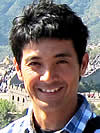 Shinya Nakamura |
2012 E.B. Burwell, Jr. Award
Presented to Shinya Nakamura, Seiichi Gibo, Kazuhiko Egashira, and
Sho Kimura
Citation by William H. Schulz
It is with great pleasure that we present the 2012 E.B. Burwell, Jr. Award to Shinya Nakamura, Seiichi Gibo, Kazuhiko Egashira, and Sho Kimura for Platy layer silicate minerals for controlling residual strength in landslide soils of different origins and geology.
Landslides are among the most hazardous of geological processes, annually causing thousands of casualties and billions of dollars in damages. Fortunately, many landslide hazards may be mitigated through engineering and construction or by temporal predictive models that forecast potentially hazardous landslide movement before it occurs. Development of proper and adequate mitigation strategies requires knowledge of landslide material shear strengths, and many landslides move far enough (generally tens of centimeters) that shear zones reach ultimate, or residual shear strength, or they move along previously sheared surfaces (e.g., sheared joints, fractures, bedding planes) that already had reached residual shear strength conditions. Measurement of residual strengths suitable for geotechnical assessments is difficult, expensive, and time consuming to perform, and results are often unclear and open to interpretation. For these reasons and more, geoscientists and engineers have long attempted to develop and refine relations between shear strength and various parameters that are much simpler to obtain, such as standard and cone penetration test results (i.e., SPT and CPT), Atterberg limits, and particle-size distributions. However, these relations provide large ranges of possible shear strengths so typically are not well-suited to landslide hazard mitigation.
Great minds in geotechnics, such as Terzaghi, Bishop, and Skempton, hypothesized that mineralogy largely controls residual shear strength. As described in this paper, Nakamura and colleagues measured residual strength of many landslide specimens using a torsional ring-shear apparatus, which provides the most accurate measures of residual strength. They also measured mineralogy of the specimens using X-ray diffraction and found that residual strength correlated well with the total content of layer silicate minerals prone to preferred orientations. The relations they developed provide excellent tools to accurately estimate residual strength from mineralogical composition, which is much simpler to obtain than direct measurements of shear strength. Hence, their paper significantly advances understanding of controls on shear-zone strength, and also advances the fields of soil mechanics and engineering geology, thereby perfectly meeting the intent of the E.B. Burwell, Jr. Award.
 2012 E.B. Burwell, Jr. Award — Response by Shinya Nakamura
2012 E.B. Burwell, Jr. Award — Response by Shinya Nakamura
Thank you, Bill, for your generous citation and nominating our paper for the 2012 E. B. Burwell, Jr. Award. It is a great honor for me and my co-authors to be the recipients of this award and we are grateful to the Environmental and Engineering Geology Division of the GSA for selecting the cited work that examines platy layer silicate mineral controls of residual shear strength of landslide soil. It is indeed a pleasant feeling to have contributed to the advancement of landslide science in general and have our work acknowledged for its merits. It is a moment of great joy for us to know that we share the same interests as far as Science is concerned, even though we are oceans apart.
Japan is a country that has learned to live with natural disasters. It is an inevitable way of life for us. We have certainly had our share of it over the years, which has caused great economic losses to the nation. Therefore, landslide science is greatly encouraged in Japan and, as a result, we have witnessed huge technological progress in landslide related research and industry. I embarked on landslide research when I was a graduate student, under the supervision of Professor Seiichi Gibo, who at that time, had established a landslide engineering laboratory at the University of the Ryukyus. I was fortunate to be associated with his work on shear strength of landslide soil. I developed a passion for this line of work and chose it as my career. Having been exposed to an array of previous literature by eminent researchers on the relations between shear strength and various parameters of soil, while working on my PhD, I was quite intrigued by the dearth of information about common parameters that could be applied to a wide range of landslide soils as an indicator of residual shear strength. It was at that time when I began to wonder if the layer silicate minerals could be a possible candidate for that purpose. We believe that platy layer silicate minerals hold the key to understanding the slide mechanisms of largely displaced landslides as well as slides involving pre-sheared surfaces that have reached residual conditions. Mineralogical analyses are quicker, compared to the extensive time involved in the measurement of actual residual shear strength in the laboratory. Well developed correlations between the platy layer silicate mineral content and residual shear strength, thus, would provide landslide engineers with quick, accurate data, thereby saving a great deal of resources.
Thanks once again to the GSA for this prestigious award. We are most humbled by the generosity that has been accorded to us. Receiving this award has encouraged us to continue researching in the fascinating world of landslide science to see what newer things we could find and share with you all.
